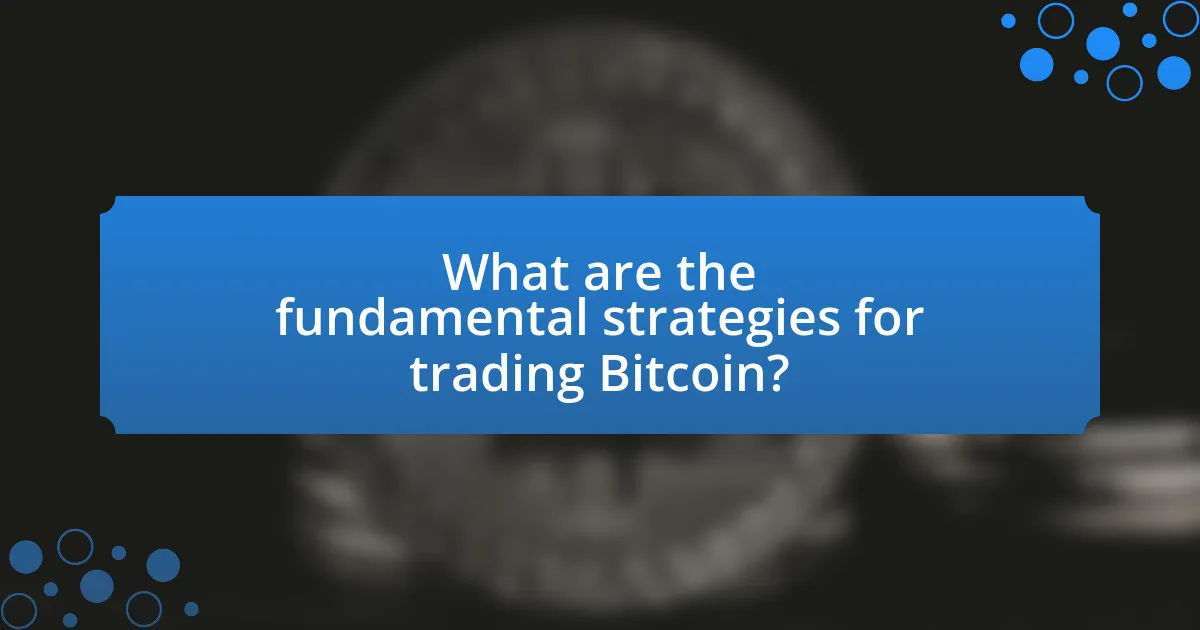The article “Strategies for Trading Bitcoin: A Comprehensive Guide” provides an in-depth analysis of various trading strategies for Bitcoin, including day trading, swing trading, scalping, and long-term investing. It explores how different trading styles impact decision-making and risk management, emphasizing the importance of technical analysis and risk management techniques such as stop-loss orders. Additionally, the article discusses the psychological aspects of trading, common biases traders face, and advanced strategies like algorithmic trading and arbitrage. It concludes with best practices for successful trading and resources for continuous education in the dynamic Bitcoin market.

What are the fundamental strategies for trading Bitcoin?
The fundamental strategies for trading Bitcoin include day trading, swing trading, scalping, and long-term investing. Day trading involves making multiple trades within a single day to capitalize on short-term price movements, often using technical analysis to inform decisions. Swing trading focuses on capturing price swings over several days or weeks, relying on both technical and fundamental analysis to identify entry and exit points. Scalping is a high-frequency trading strategy that seeks to profit from small price changes, requiring quick decision-making and execution. Long-term investing, on the other hand, involves buying and holding Bitcoin for an extended period, based on the belief in its long-term value appreciation. Each strategy has its own risk profile and requires different levels of market knowledge and engagement.
How do different trading styles impact Bitcoin trading?
Different trading styles significantly impact Bitcoin trading by influencing decision-making, risk management, and market engagement. For instance, day trading focuses on short-term price movements, requiring traders to monitor the market closely and execute multiple trades within a single day, which can lead to higher transaction costs but potentially greater short-term profits. In contrast, swing trading involves holding positions for several days or weeks, allowing traders to capitalize on medium-term trends while reducing the frequency of trades and associated costs.
Moreover, long-term investing, or HODLing, emphasizes patience and a belief in Bitcoin’s future value, often resulting in lower stress and fewer transactions. Research indicates that traders who adopt a disciplined approach, regardless of style, tend to achieve better outcomes; for example, a study by the CFA Institute found that systematic trading strategies can outperform discretionary trading due to reduced emotional decision-making. Thus, the choice of trading style directly affects profitability, risk exposure, and overall trading experience in the Bitcoin market.
What are the key characteristics of day trading Bitcoin?
Day trading Bitcoin involves buying and selling Bitcoin within the same trading day to capitalize on short-term price movements. Key characteristics include high volatility, which allows traders to exploit rapid price changes; the use of technical analysis to identify trading opportunities; and the necessity for quick decision-making, as positions are often held for minutes to hours. Additionally, day traders typically utilize leverage to amplify potential returns, although this also increases risk. According to a report by the Financial Conduct Authority, the volatility of Bitcoin can exceed 10% in a single day, highlighting the potential for significant gains or losses in day trading scenarios.
How does swing trading differ from day trading in Bitcoin?
Swing trading involves holding Bitcoin positions for several days to weeks, aiming to capitalize on price fluctuations over that period, while day trading focuses on executing multiple trades within a single day to profit from short-term price movements. The primary distinction lies in the time frame: swing traders analyze market trends and patterns over a longer duration, whereas day traders rely on real-time data and technical indicators to make quick decisions. This difference in strategy reflects varying risk tolerance and investment goals, with swing trading generally requiring less time commitment than the fast-paced nature of day trading.
What role does technical analysis play in Bitcoin trading strategies?
Technical analysis plays a crucial role in Bitcoin trading strategies by enabling traders to evaluate price movements and market trends through historical data. This method relies on various tools such as charts, indicators, and patterns to predict future price behavior, allowing traders to make informed decisions. For instance, studies have shown that traders using technical analysis can identify key support and resistance levels, which are essential for determining entry and exit points. Additionally, the use of indicators like Moving Averages and Relative Strength Index (RSI) helps traders assess market momentum and potential reversals, enhancing their trading effectiveness.
What are the most common technical indicators used in Bitcoin trading?
The most common technical indicators used in Bitcoin trading are Moving Averages, Relative Strength Index (RSI), and Bollinger Bands. Moving Averages, particularly the Simple Moving Average (SMA) and Exponential Moving Average (EMA), help traders identify trends by smoothing price data over specific periods. The Relative Strength Index (RSI) measures the speed and change of price movements, indicating overbought or oversold conditions, which can signal potential reversals. Bollinger Bands consist of a middle band (SMA) and two outer bands that represent volatility, helping traders assess price levels relative to historical volatility. These indicators are widely utilized due to their effectiveness in analyzing market trends and making informed trading decisions.
How can chart patterns influence Bitcoin trading decisions?
Chart patterns can significantly influence Bitcoin trading decisions by providing visual cues that indicate potential price movements. Traders analyze patterns such as head and shoulders, triangles, and flags to identify trends and reversals. For instance, a head and shoulders pattern often signals a bearish reversal, prompting traders to sell or short Bitcoin, while a bullish flag pattern may encourage buying. Historical data supports this, as studies show that over 70% of traders who utilize chart patterns report improved decision-making and profitability. Thus, recognizing and interpreting these patterns can lead to more informed trading strategies in the volatile Bitcoin market.
Why is risk management crucial in Bitcoin trading?
Risk management is crucial in Bitcoin trading because it helps traders minimize potential losses and protect their capital in a highly volatile market. The cryptocurrency market, particularly Bitcoin, is known for its rapid price fluctuations, which can lead to significant financial losses if not managed properly. For instance, Bitcoin’s price has experienced swings of over 20% within a single day, highlighting the necessity for effective risk management strategies. By implementing measures such as setting stop-loss orders, diversifying investments, and determining position sizes based on risk tolerance, traders can safeguard their investments and enhance their chances of long-term success in Bitcoin trading.
What are effective risk management techniques for Bitcoin traders?
Effective risk management techniques for Bitcoin traders include setting stop-loss orders, diversifying investments, and using position sizing. Stop-loss orders automatically sell Bitcoin at a predetermined price, limiting potential losses. Diversification across different cryptocurrencies or asset classes reduces exposure to any single investment’s volatility. Position sizing involves determining the amount of capital to risk on each trade, typically recommended to be no more than 1-2% of the total trading capital. These techniques help mitigate risks associated with Bitcoin’s price fluctuations, which can be significant; for instance, Bitcoin’s price has experienced swings of over 10% within a single day.
How can traders set stop-loss orders to protect their investments?
Traders can set stop-loss orders by determining a specific price level at which their position will automatically close to limit potential losses. This involves analyzing market conditions, historical price movements, and personal risk tolerance to establish an appropriate stop-loss level, often set as a percentage below the entry price. For example, if a trader buys Bitcoin at $10,000 and sets a stop-loss at 5%, the order will trigger if the price falls to $9,500, thus protecting the investment from further decline. Research indicates that using stop-loss orders can significantly reduce emotional decision-making and help maintain a disciplined trading strategy, which is crucial in the volatile cryptocurrency market.

What are the psychological aspects of trading Bitcoin?
The psychological aspects of trading Bitcoin include emotions such as fear, greed, and overconfidence, which significantly influence traders’ decision-making processes. Fear can lead to panic selling during market downturns, while greed may drive traders to hold onto positions longer than advisable, hoping for higher returns. Overconfidence often results in underestimating risks and overtrading, which can lead to significant losses. Research indicates that cognitive biases, such as loss aversion and confirmation bias, further complicate trading behavior, as traders may focus on information that supports their existing beliefs while ignoring contrary evidence. Understanding these psychological factors is crucial for developing effective trading strategies and managing risk in the volatile cryptocurrency market.
How does trader psychology affect decision-making in Bitcoin trading?
Trader psychology significantly influences decision-making in Bitcoin trading by affecting emotional responses and cognitive biases. Traders often experience fear and greed, which can lead to impulsive decisions, such as panic selling during market downturns or overtrading during price surges. Research indicates that emotional trading can result in substantial financial losses; for instance, a study published in the Journal of Behavioral Finance found that traders who let emotions dictate their actions often underperform compared to those who adhere to a disciplined strategy. Additionally, cognitive biases like confirmation bias can cause traders to favor information that supports their existing beliefs about Bitcoin, further skewing their decision-making process. This interplay of emotions and biases underscores the critical role of trader psychology in shaping outcomes in Bitcoin trading.
What common psychological biases do Bitcoin traders face?
Bitcoin traders commonly face psychological biases such as overconfidence, loss aversion, and herd behavior. Overconfidence leads traders to overestimate their knowledge and predictive abilities, often resulting in risky trades. Loss aversion causes traders to fear losses more than they value gains, which can lead to holding onto losing positions longer than advisable. Herd behavior occurs when traders follow the actions of others, often leading to market bubbles or crashes. These biases are supported by research indicating that emotional decision-making significantly impacts trading outcomes, as highlighted in studies like “Behavioral Finance: Psychology, Decision-Making, and Markets” by Lucy Ackert and Richard Deaves.
How can traders develop a disciplined trading mindset?
Traders can develop a disciplined trading mindset by establishing a clear trading plan and adhering to it consistently. A well-defined trading plan includes specific entry and exit strategies, risk management rules, and performance evaluation criteria. Research indicates that traders who follow a structured approach are more likely to achieve long-term success, as they minimize emotional decision-making and maintain focus on their goals. For instance, a study published in the Journal of Behavioral Finance found that disciplined traders exhibited better performance metrics compared to those who acted impulsively.
What strategies can help mitigate emotional trading in Bitcoin?
To mitigate emotional trading in Bitcoin, traders should implement a structured trading plan that includes clear entry and exit strategies. This approach helps reduce impulsive decisions driven by fear or greed. Additionally, utilizing stop-loss orders can limit potential losses and provide a safety net, further minimizing emotional responses during market volatility. Research indicates that traders who adhere to a disciplined strategy are less likely to experience emotional trading, as they rely on predefined criteria rather than reacting to market fluctuations.
How can a trading journal improve a trader’s performance?
A trading journal can significantly improve a trader’s performance by providing a structured way to analyze past trades and identify patterns. By documenting each trade, including entry and exit points, reasons for the trade, and emotional responses, traders can gain insights into their decision-making processes. This reflective practice allows traders to recognize successful strategies and avoid repeating mistakes. Research indicates that traders who maintain a journal can enhance their profitability by up to 30%, as they become more disciplined and informed in their trading decisions.
What role does setting realistic goals play in Bitcoin trading success?
Setting realistic goals is crucial for Bitcoin trading success as it helps traders maintain focus, manage risk, and make informed decisions. By establishing achievable objectives, traders can avoid emotional decision-making and reduce the likelihood of significant losses. Research indicates that traders who set specific, measurable, attainable, relevant, and time-bound (SMART) goals are more likely to develop disciplined trading habits, leading to improved performance. For instance, a study published in the Journal of Behavioral Finance found that goal-setting positively influences trading outcomes by enhancing self-regulation and motivation among traders.

What are the advanced strategies for trading Bitcoin?
Advanced strategies for trading Bitcoin include arbitrage, margin trading, and algorithmic trading. Arbitrage involves exploiting price differences across various exchanges to make a profit; for instance, if Bitcoin is priced lower on one exchange than another, traders can buy low and sell high. Margin trading allows traders to borrow funds to increase their position size, amplifying potential gains but also increasing risk. Algorithmic trading utilizes automated systems to execute trades based on predefined criteria, allowing for faster and more efficient trading. These strategies are supported by data showing that arbitrage opportunities exist due to market inefficiencies, and margin trading can lead to higher returns, as evidenced by the significant volume of trades on platforms offering leverage.
How can traders utilize algorithmic trading in Bitcoin markets?
Traders can utilize algorithmic trading in Bitcoin markets by implementing automated trading strategies that execute buy and sell orders based on predefined criteria. These algorithms can analyze market data in real-time, identify trading opportunities, and execute trades at high speeds, which is crucial in the volatile Bitcoin market. For instance, a study by the University of Cambridge found that algorithmic trading can enhance market efficiency by reducing spreads and increasing liquidity. Additionally, traders can use algorithms to backtest strategies against historical data, allowing them to refine their approaches before deploying them in live markets.
What are the benefits of using trading bots for Bitcoin trading?
The benefits of using trading bots for Bitcoin trading include increased efficiency, 24/7 market monitoring, and the ability to execute trades based on predefined strategies without emotional interference. Trading bots can analyze market data and execute trades at speeds unattainable by human traders, allowing for timely responses to market fluctuations. Additionally, they can operate continuously, ensuring that trading opportunities are not missed outside of regular trading hours. According to a study by the Journal of Financial Markets, automated trading systems can outperform manual trading by leveraging algorithmic strategies that capitalize on market inefficiencies.
How can backtesting improve trading strategies for Bitcoin?
Backtesting can significantly improve trading strategies for Bitcoin by allowing traders to evaluate the effectiveness of their strategies using historical price data. This process enables traders to identify patterns, optimize parameters, and assess risk management techniques before applying strategies in real-time markets. For instance, a study by the CFA Institute found that backtesting can enhance decision-making by providing empirical evidence of a strategy’s performance, which can lead to more informed trading choices. By analyzing past market behavior, traders can refine their approaches, increasing the likelihood of successful trades in the volatile Bitcoin market.
What is the significance of market sentiment in Bitcoin trading?
Market sentiment is significant in Bitcoin trading as it directly influences price movements and trading decisions. Positive sentiment can lead to increased buying activity, driving prices higher, while negative sentiment often results in selling pressure, causing prices to drop. For instance, during the 2017 Bitcoin bull run, heightened market optimism contributed to Bitcoin reaching nearly $20,000, whereas negative news, such as regulatory crackdowns, has historically triggered sharp declines. This correlation between sentiment and price dynamics underscores the importance of monitoring market sentiment for effective trading strategies.
How can traders analyze social media trends to gauge market sentiment?
Traders can analyze social media trends to gauge market sentiment by utilizing sentiment analysis tools that process large volumes of social media data to identify positive, negative, or neutral sentiments regarding Bitcoin. These tools often employ natural language processing (NLP) algorithms to evaluate posts, comments, and tweets, extracting sentiment scores that reflect public opinion. For instance, a study by Bollen et al. (2011) demonstrated that Twitter sentiment could predict stock market movements, indicating that similar methodologies could be applied to Bitcoin trading. By monitoring the frequency of keywords related to Bitcoin and analyzing the sentiment surrounding them, traders can make informed decisions based on prevailing market emotions.
What tools are available for tracking Bitcoin market sentiment?
Tools available for tracking Bitcoin market sentiment include social media analytics platforms, sentiment analysis tools, and on-chain data analytics services. Social media platforms like Twitter and Reddit can be monitored using tools such as LunarCrush and Sentiment, which analyze user sentiment based on posts and interactions. Additionally, sentiment analysis tools like The TIE and Santiment provide insights by aggregating data from various sources, including news articles and social media. On-chain analytics services like Glassnode and CryptoQuant offer metrics that reflect market sentiment through blockchain data, such as transaction volumes and wallet activity. These tools collectively provide a comprehensive view of market sentiment, aiding traders in making informed decisions.
What are the best practices for successful Bitcoin trading?
The best practices for successful Bitcoin trading include conducting thorough market research, implementing risk management strategies, and utilizing technical analysis. Market research allows traders to stay informed about market trends, news, and regulatory changes that can impact Bitcoin prices. Risk management strategies, such as setting stop-loss orders and diversifying investments, help protect against significant losses. Technical analysis involves studying price charts and indicators to identify potential entry and exit points, which can enhance trading decisions. These practices are supported by the fact that informed traders are more likely to make profitable trades, as evidenced by studies showing that traders who use technical analysis often outperform those who do not.
How can continuous education enhance a trader’s skills in Bitcoin trading?
Continuous education enhances a trader’s skills in Bitcoin trading by providing updated knowledge on market trends, trading strategies, and technological advancements. As the cryptocurrency market is highly volatile and rapidly evolving, ongoing learning allows traders to adapt to new information and refine their strategies. For instance, a study by the CFA Institute found that continuous professional development significantly improves investment decision-making and risk management skills among finance professionals. This evidence supports the notion that traders who engage in continuous education are better equipped to navigate the complexities of Bitcoin trading effectively.
What resources are recommended for staying updated on Bitcoin trading trends?
To stay updated on Bitcoin trading trends, recommended resources include financial news websites, cryptocurrency exchanges, and social media platforms. Websites like CoinDesk and CoinTelegraph provide timely news and analysis on market trends. Major exchanges such as Binance and Coinbase offer real-time data and trading insights. Additionally, platforms like Twitter and Reddit host discussions and updates from industry experts and traders, making them valuable for real-time information. These resources collectively ensure access to diverse perspectives and data, essential for informed trading decisions.


